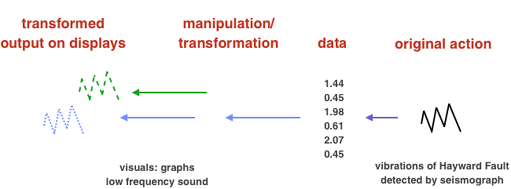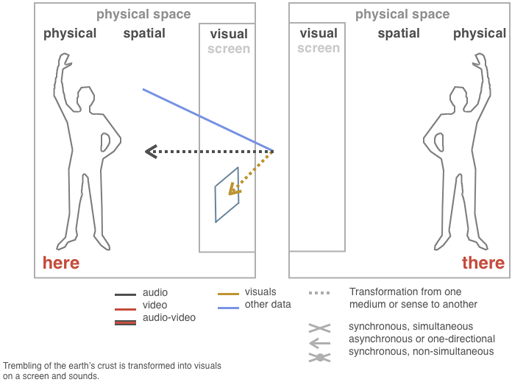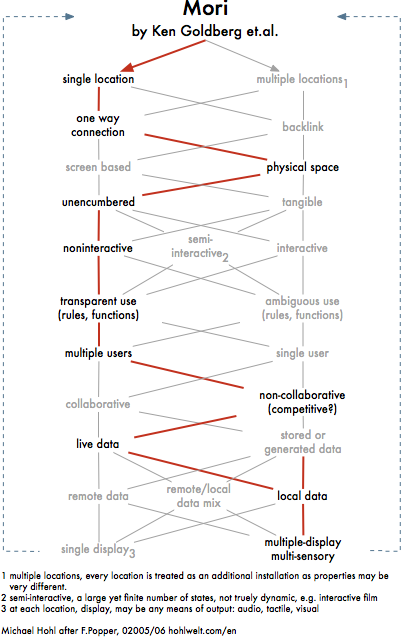Ken Goldberg, Randall Packer, Wojciech Matusik and Gregory Kuhn: "Mori," 1999-"In Mori, the immediacy of the telematic embrace between earth and visitor questions the authenticity of mediated experience in the context of chance, human fragility, and geological endurance.” Goldberg |
 Image: by K.Goldberg |
||
|
The installation consists of a darkened space into which visitors are led by an illuminated path arranged in the shape of an inward moving spiral. Michael Heim, probably inspired by Carl Jung's writings on Alchemy referres to the spiral as something "that brings us to ourselves." 1 In native american Hopi mythology the spiral is a symbol of Mother Earth. At the centre of the spiral a screen is embedded into the floor surrounded by a circular railing. Low sound frequencies are emanated by hidden loudspeakers, reverberating the space. These sounds correspond with the visuals on the screen which represent the seismographs graphical output. 
|
|||
|
In that relation Telepresence is often compared to Virtual Reality (VR) as both share the use of data from "another place." In Telepresence this is a remote location which we experience via a technology mediated representation, whereas in VR it is the computer generated simulation of a virtual, a non-existing, imaginary "place." Both share data that are gathered and presented by complex technical set-ups in a process that usually is non-intuitive and non-transparent, a black box. Although sometimes the created outputs simulate natural reality, this "naturalism" is the result of a conscious design effort, with every detail being the result of a design effort. All properties regarding visuals or sounds and subtlest behaviours of the interface are determined and created via computer mediation and in this process are modified and altered. Sometimes beyond recognition, sometimes according to expectations. This result, also appearing to be "natural" is completely artificial and make-believe only. |
|||
ConclusionThere appears to be a contradiction between the large scale installation piece - and the small monitor at its centre. (As I have not experienced this piece myself this is mere speculation.) The space is accessed in a choreographed approach that results in an immersive experience. An uncanny darkness, increasing sound volume during the approach, and the final revelation at its mystical/enchanted centre. One would expect that visitors experience the rather unspectacular and small CRT monitor found at this point of focus bearing a very reduced and unemotional animated black and white curve as too simple, but obviously this is not the case. The installation, its sound and the set-up appear to create a well designed whole. |
|||
Transformation in "Mori"

|
|||
Here/there: Transformation and SpatialityAlthough technically the seismograph sending the data is located in a distance conceptually the work is about the ground beneath the visitors feet. As a result of this decision there is no 'there' there. It is about here and now. 
|
|||
Links:http://www.zakros.com/projects/mori.html Zakros's Mori page with video walkthrough. |
|||
Classification of Mori as an interactive installation
|
|
||
| last update: 1/7/02008 0:53 About Contact Disclaimer Glossary Index |
|||
